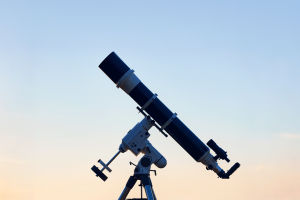When we were younger, we only knew the planets in our own solar system — the four rocky planets, the four gas giants, and a handful of other objects like moons, asteroids, comets, and Pluto (which was still considered the ninth planet at the time).
All of these were just part of our small solar system, and when we grew up, we learned that our Sun is just one of 200 billion to 400 billion stars in the Milky Way. Gazing at the stars, we couldn't help but wonder: how many planets are there around all these stars? And how many planets are there in the entire universe?
How Stars Form in the Milky Way
Decades ago, discussions about the number of planets in the Milky Way were mostly speculative. Our focus was mainly on stars. The stars in our universe vary greatly in size, mass, and color. Our Sun is just a G-type star, one of seven main star types. In the chart below, we can see that our Sun's luminosity is on the dimmer side compared to others. In fact, most of the stars we see in the night sky belong to the O, B, or A types, or they are highly evolved red giants, which are extremely bright. However, the closest star to Earth, Proxima Centauri, is a dim red dwarf, which can't even be seen with the unaided eye unless you use a medium-sized telescope.
The Common Red Dwarf Star System
Our Sun is much brighter and more massive than about 95% of the stars in the universe. Red dwarf stars (M-type stars) have a mass between 8% and 40% of the Sun's mass. In fact, about three out of every four stars in the Milky Way are red dwarfs. More importantly, while our Sun's system is a single-star system, this is not the most common setup in the universe. Most stars exist in binary star systems, triple star systems, or even in clusters with hundreds or thousands of stars. So, our single-star system is quite rare.
Estimating the Number of Planets in the Milky Way
To accurately estimate how many planets exist in the Milky Way, we can't just multiply the number of planets found around a few stars by the total number of stars in the universe. That would be a naive estimate, especially in the absence of evidence. This simple estimate suggests that the Milky Way might have around 2 to 3 trillion planets (not counting moons!).
How We Discover Planets
Over the past 20 years, we've used various methods to explore the number of planets in our universe, with two methods standing out: the "stellar wobble" method and the "transit method." The stellar wobble method works by observing the tiny gravitational "wobble" a star experiences due to the presence of planets, which helps us estimate the number, mass, and size of the planets. The transit method, on the other hand, observes how a planet passing in front of a star blocks some of its light, which can tell us how many planets exist around a star.
The Kepler Mission's Discoveries
When using the transit method to detect planets, we can only observe a small fraction of the planets. For example, NASA's Kepler mission, which observed the brightness of 100,000 stars to detect transits, only found a few thousand planets. Does this mean there are only a few planets around every hundred stars? That would be highly unlikely. If Kepler had observed our solar system, it would have seen many more planets because the chance of seeing a planet transit across the face of a star is quite small. In fact, Kepler could only detect planets that were large enough and close enough to their stars to cause noticeable dips in the light.
The Surprising Findings of Kepler
By now, Kepler has discovered over 11,000 stars, with more than 18,000 potential planets orbiting them. This tells us some fascinating things:
• The universe is full of different types of planetary systems, many of which are unlike our own.
• Planets orbit all sorts of stars, including binary and triple star systems.
• Kepler mostly detects planets that are large and close to their stars.
How Many Planets Are There in the Milky Way?
Estimates suggest that there are at least 100 to 200 billion planets in the Milky Way, but this is just a lower bound. If we estimate more accurately, we get a number closer to 10 trillion planets in our universe alone! And that's not even including "rogue" planets that don't orbit any star—they might vastly increase the number of planets in our universe.
The Universe's Trillions of Planets
As we continue to improve our planet-detection techniques, we'll get more accurate numbers. But for now, we know that our solar system's planet count is likely either a bit higher or a bit lower than the average for the Milky Way's star systems. And remember, our universe is just one of about 200 billion galaxies in the universe. This means the universe is likely home to around 10^25 planets!
In other words, in our observable universe, there might be 10,000,000,000,000,000,000,000,000 planets—that's a number so large it's hard to even imagine. And that's just the current lower estimate! So, the next time someone asks you how many planets there are in the Milky Way or the universe, just smile and say, “We don't know for sure, but it's probably a lot!”
Looking Ahead
We're still refining our planet-detection methods, and we can only imagine what the future holds. But one thing is for sure: Our universe is full of planets, and there are many more to discover. The search for planets with water, oxygen, and signs of life continues, and who knows? One day, we might just find another Earth out there.
Lykkers, isn't it mind-blowing to think about how many planets could be out there in the universe? What do you think—do you believe we'll find signs of life elsewhere? Let me know your thoughts!


